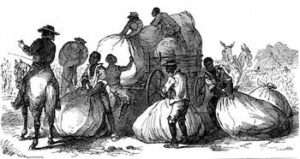
*The Slave Revolt in the Cherokee Nation began on this date in 1842. It was the largest escape of enslaved Africans in the Cherokee Nation, Indian Territory of America.
Before the white-European invasion, the Cherokee practiced enslaving prisoners of war from other Indian tribes. In the late 18th century, some set up European-American-style plantations on their Cherokee Nation land near parts of Georgia and Tennessee. They purchased enslaved Africans to work on this land. In 1819, the Cherokee Nation passed slave codes that regulated the slave trade, banned intermarriage, detailed punishment for runaway slaves, and prohibited enslaved people from owning property.
An 1820 law regulated trading with enslaved people. It required that anyone trading an enslaved person without the master's permission was bound to the legal owner for the property or its value. Another code declared a fine for masters who allowed enslaved people to buy or sell liquor. The Cherokee adopted the practice of using enslaved Africans on their plantations from European Americans. Most Cherokee held fewer enslaved people and labored with them in subsistence agriculture.
Enslaved people cultivated cotton for their master's profit and food for consumption. Some enslaved people were skilled seamstresses and blacksmiths. Like other slaveholders, wealthy Cherokee used enslaved people as a portable labor force. They developed farms, salt mines, and trading posts with slave labor.
The Slave Revolt in the Cherokee Nation began when a group of 20 enslaved Africans owned by the Cherokee escaped and tried to reach Mexico, where slavery had been abolished in 1829. They were joined by 15 enslaved people escaping from the Creek Nation in Indian Territory along their way south. The fugitives met with two slave catchers, taking a family of eight slave captives back to the Choctaw Nation.
The Cherokee brought many of their slaves with them to the West in the Indian Removal Act when the federal government forcibly removed them from the Southeastern states. For example, they loaded wagons, cleared the roads, and led livestock teams. By 1835, the time of removal, the Cherokee owned an estimated total of 1500 enslaved Africans (the most of any of the Five Civilized Tribes). Within five years of displacement, 300 mixed-race Cherokee families, most descendants of European traders and Cherokee women for generations, comprised an elite class in the Indian Territory. Most owned 25–50 enslaved people each. Some of their plantations had 600 to 1,000 acres, cultivating wheat, cotton, corn, hemp, and tobacco. Most of the men also had large cattle and horse herds.
The fugitives killed the hunters and allowed the family to join their party. The Cherokee sought reinforcements. They raised over 100 of their Choctaw warriors armed to pursue and capture the fugitives. Five enslaved people were executed for killing the two slave catchers. The 1842 episode inspired subsequent slave rebellions in the Indian Territory. However, the Cherokee Nation passed stricter slave codes, expelled freedmen from the Territory, and established a 'rescue' (slavecatching) company to prevent additional losses.
The slaveholder Joseph Vann was killed two years later, in 1844, in the Lucy Walker steamboat disaster. By 1860, the Cherokee held an estimated 4,600 enslaved people and depended on them as farm laborers and domestic servants. At the time of the Civil War, more than 8,000 enslaved people were held in all of the Indian Territory, where they comprised 14 percent of the population. The slave revolt threatened the security of the labor force and owners' profits. The Nation passed a stricter slave code and required the expulsion of free blacks from the Territory, as they were considered to foster discontent among enslaved people.
After the American Civil War, planters and the upper-class Cherokee Nation shifted from plantation agriculture to developing the manufacture of small-scale products, which were sold internally instead of being exported. As a mass escape that resulted in casualties and deaths of both enslaved people and others, the 1842 slave revolt was widely reported by newspapers.